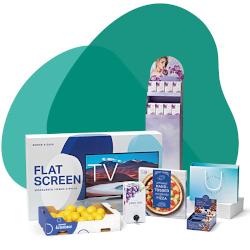
Unboxing experience: How packaging strengthens customer retention
In the modern world of e-commerce, the experience of opening packaging is increasingly important – and plays a key role in establishing a brand’s image.

The unboxing experience has become an effective customer retention and marketing tool, and one that brand owners can use to great effect. Did you know that a free product demonstration on social media such as YouTube, Facebook, Instagram or Snapchat can serve as a valuable online tool for word-of-mouth marketing? And that the pure experience of unboxing offers a fantastic opportunity for brands to set themselves apart?
The facts are clear, as you can see from the following data:
- Unboxing videos are some of the most-viewed videos on YouTube
- More than 90,000 people search for ‘unboxing’ every month on YouTube
- Almost 40 unboxing videos have achieved more than 10 million views
- The unboxing experience covers every possible product and appears in practically every language all over the world

What is unboxing ?
Literally, unboxing refers to the process of removing a product from its packaging with relish and excitement. The term is used in the context of an experience where the process is filmed and the video published on YouTube or other social networks.
And while the original function of packaging was to protect products during shipping, online retailers have now realised that the unboxing experience itself offers a unique opportunity to create an emotional brand experience for the customer.
How mirror neurons influence us during unboxing
Thanks to the nature of e-commerce, the first physical contact with a product may only occur when it is removed from its packaging. Previous types of point-of-sale brand experiences – such as touch and smell – are impossible online and need to be recreated for the buyer in their home.
That’s why, according to neuromarketing experts, unboxing at home can be crucial for brand development and loyalty. For this, we have our mirror neurons to thank – the joy experienced from watching products being unboxed links back to the same synapses that make us empathetic people. These are activated not only when we undertake a rewarding action ourselves, but also when we observe other people doing exactly that. We project their experience onto ourselves and resonate with it.
Why packaging design is so important
Packaging is the central element in a successful unboxing experience – and it provides brands with a key opportunity to effectively stand out from the crowd. It’s more important than ever for brand owners, designers and packaging manufacturers to focus on wowing customers with attractive packaging designs.
Alongside the product packaging itself, the shipping packaging in which it is encased should also reflect the brand’s values. This might take the form of a premium quality, extremely innovative design, or perhaps feature individual special elements such as personal messaging.
When packaging tells an authentic brand story
To create a memorable unboxing experience, packaging plays a central role by:
- Strengthening customer retention
- Enhancing brand image
- Adding a touch of class

This is true for everything from day-to-day consumer goods to high-end electronics and luxury purchases. There are even special websites where empty packaging bearing brand names such as Gucci, Chanel or Louis Vuitton is sold at handsome prices.
What these brands have understood about their packaging is the value of originality, creativity, authenticity – and the consumer’s emotional experience.
5 Packaging tips for a unique unboxing experience
1. Design the external packaging
The shipping box is usually made of corrugated cardboard and is the first thing to be opened – which makes it one of the most important packaging elements. To personalise this, it can be printed with lettering, logos or other motifs in a unique design, particularly on the inside.
2. Use packing tape and paper
Why just use brown tape or plain packing paper when packing tape and paper can easily be decorated with branded elements or given matching colours? The same applies to the filler material or inlays inside.
3. Use stickers and seals
Customer loyalty can be strengthened by means of discreet promotional materials in your corporate design featuring, for example, links to online touch points or personalised product suggestions.
4. Add a personal note
You can further enhance the customer experience by including a personalised card with a clever or funny brand message, entertaining instructions for use or discount vouchers for a next purchase.
5. Make the product packaging stand out
The more original the design of the actual product packaging, the greater the wow effect when the product is unboxed. And, as this packaging is protected during shipping, there are no limits to the design, printing or finishing techniques you can make the most of.

Sappi liner for packaging made from corrugated board and more
Whether it’s as an inlay for cosmetics and confectionery packaging or for shipping packaging made from solid or corrugated board, to catch the eye in online sales, high-quality topliner and inner liner papers are vital to ensure a unique unboxing experience.
Luis Mata, Sales Director Packaging and Digital Solutions at Sappi Europe, takes the latest Sappi innovation as an example: ‘With Fusion Nature Plus, we are enabling brand owners to respond to the fact that the POS is increasingly moving away from the high street and towards online shopping. In comparison to conventional, uncoated fine papers, Fusion Nature Plus offers an impressive level of brightness, brilliant colour reproduction and consistently high quality. This enables the virgin fibre liner to be used for e-commerce and digital printing, which makes for an outstanding unboxing experience.’
Mata also stresses the importance of sustainability:
‘Fusion Nature Plus consists of virgin fibres that are crucial for recycling. They also ensure lighter weights with the same level of strength. And, because we acquire the fibres for our Ehingen central European plant from local sources, transport and delivery costs as well as CO2 emissions are also minimised.’







